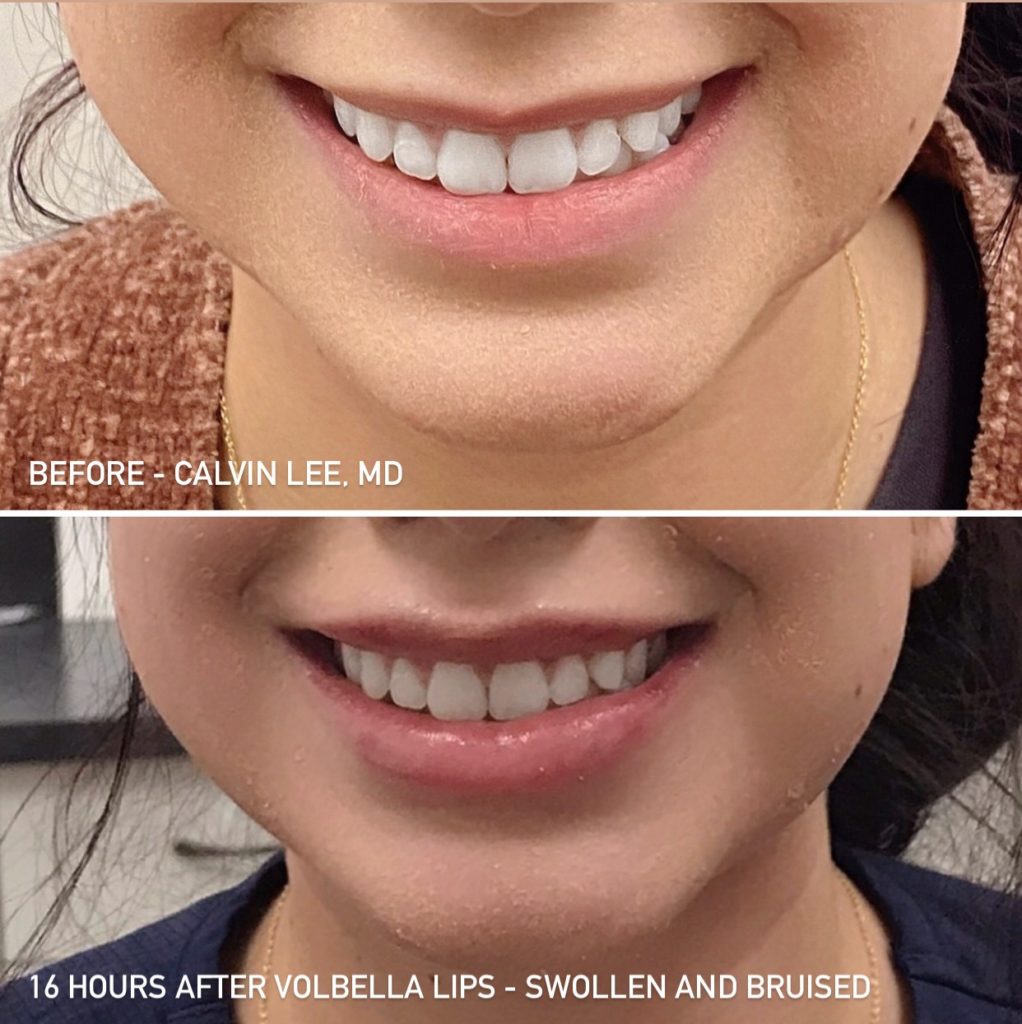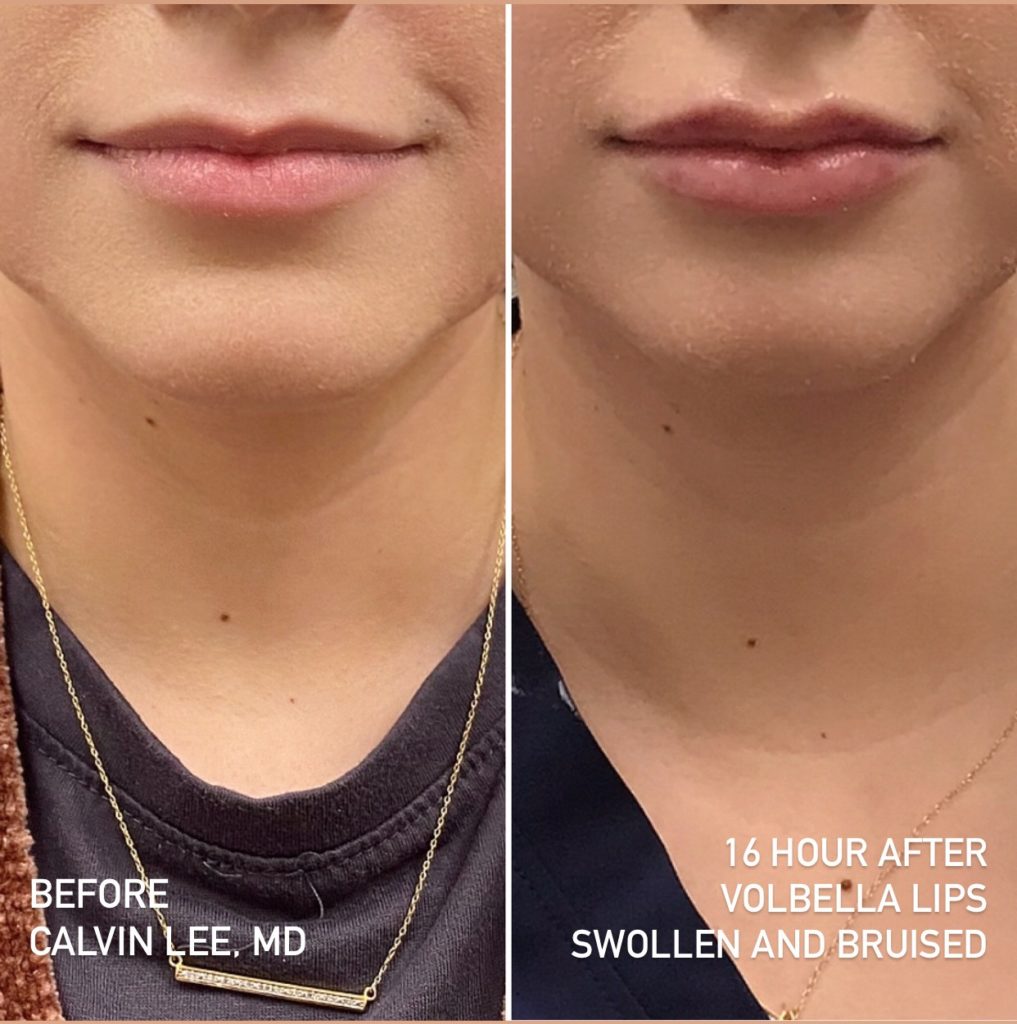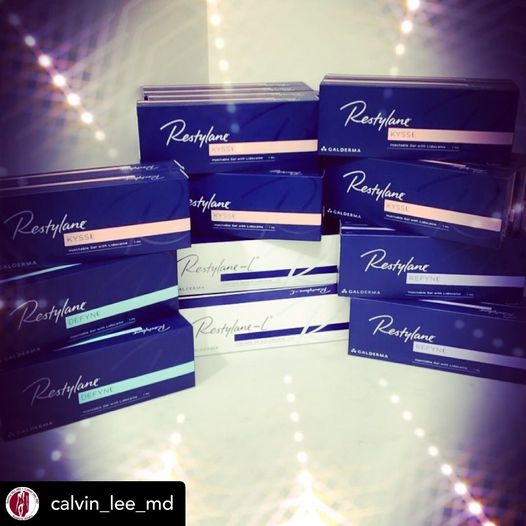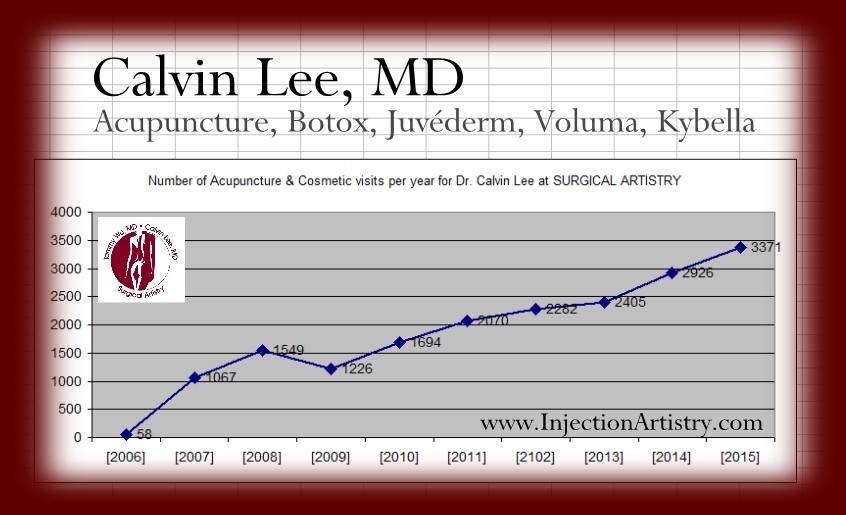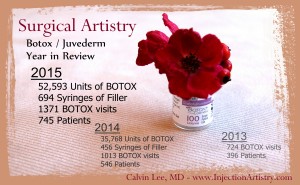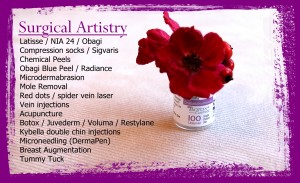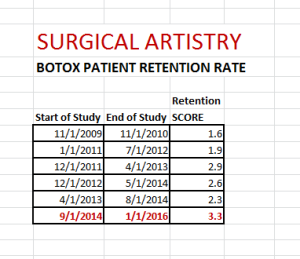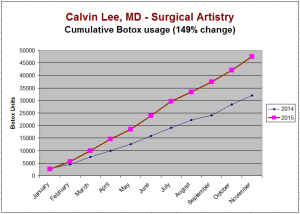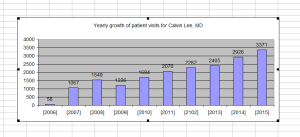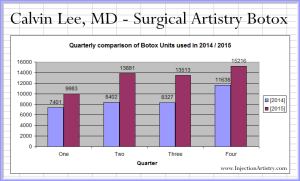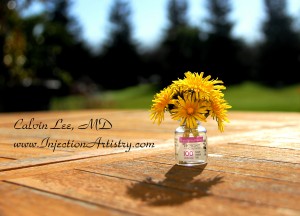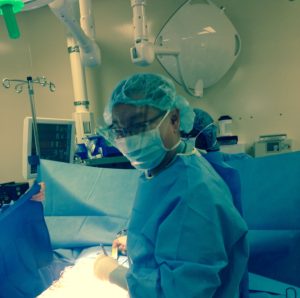 I was recently asked to answer these questions as part of a student’s assignment for school. She wanted a surgeon to interview. I have elected to answer these questions as the surgeon that I am today which is different from a decade ago when I was a trauma/general surgeon. Now I am a surgeon who does acupuncture and cosmetic injections (Botox, Fillers, Kybella – neck, Asclera – veins). For more information, consider visiting my other webpages www.InjectionArtistry.com and www.SurgeryToday.com
I was recently asked to answer these questions as part of a student’s assignment for school. She wanted a surgeon to interview. I have elected to answer these questions as the surgeon that I am today which is different from a decade ago when I was a trauma/general surgeon. Now I am a surgeon who does acupuncture and cosmetic injections (Botox, Fillers, Kybella – neck, Asclera – veins). For more information, consider visiting my other webpages www.InjectionArtistry.com and www.SurgeryToday.com
- Describe your work environment.
I am a surgeon with additional training with acupuncture and cosmetic injections. I have worked as a general surgeon and trauma surgeon. In 2006, I decided that I was going to dedicate my surgical skills to working with needles for the majority of my work as a doctor. I became an acupuncturist and learned cosmetic surgery from my wife, Dr. Tammy Wu, who is a plastic surgeon. Our practice is Surgical Artistry, and one of the main focuses of the practice is cosmetic surgery. About once or twice a month, I have days where I assist the entire day in surgeries with Dr. Wu or other surgeons in our area. For the most part, I am now mostly an office based doctor – as opposed to one who sees patients in the hospital. I use three different acupuncture rooms to see patients with varying problems ranging from back pain, neck pain, headaches, athletic injuries to fertility acupuncture. And then I have one large procedure room where I see my cosmetic injection patients. The lighting and space design is different in each of these rooms based on the procedure intended for the room. Surgical Artistry has two physicians – myself and my wife, and at this time 4 full time employees. We like to keep our work environment clean and neat and be a sanctuary for health and wellness. It has an open feel to the environment for our employees as we want to foster good communication with our team. We believe in having our patients be beautiful both with health and appearance.
- What’s a typical day at work like?
As a surgeon who focuses on acupuncture and cosmetic injections, I see patients from 8am-5pm. I try to start on time as much as possible and I try to stick to the schedule. I dislike having patients wait. Half of my usual day is dedicated to acupuncture and the other half to cosmetic injections. I go from room to room with no break in between. I find time for my “breaks” when patients don’t show up or are late to the office. That is when I prepare a batch of Botox, catch up on emails, enjoy some facebook (my facebook page), maybe even grab a quick bite. I don’t take a formal lunch break. I usually work till about 5:05pm. That’s when I start to have time to write my office medical charts which are important to document the day’s work. This allows me to record for future medical use when the patients come back, and thus, I can improve on their care. The medical charting usually takes me about 1-3 hours. Then I go home. But sometimes I have to take care of business matters especially since Surgical Artistry is my business. Sometimes there are employee matters, bills that need to be paid, or leaking roof issues. So at times I don’t go home till 1am in the morning. This is pretty much most of my days Monday-Friday. There are a few days per month which I reserve for surgery assisting where I give my staff a break from my daily grind; I am not at the office on that day, I would spend my day at the hospital going from surgery to surgery. And my staff spends that day catching up on their paperwork in the office. The hospital and my office are not connected. I think there are some lucky doctors who have an office inside a hospital. Or maybe they consider themselves unlucky because they never get out of that work environment. Regardless, I have to drive to the hospital from my office and I work at a handful of hospitals such as Stanislaus Surgical Hospital, Doctors Medical Center in Modesto, and Sutter Memorial Hospital in Memorial. on Stanislaus Surgical Hospital’s home page, they actually have a picture of me as the operating surgeon on their header!
- What are the three most important responsibilities of your job?
First most important responsibility is getting the patient the best results that I can. Second most important responsibility is to do this as safely as I can. This involves good technique and good knowledge. The third most important responsibility is managing patient expectations – which means that I should spend the time communicating well with the patient and letting the patient ask questions, and I should try to think of questions that the patient might not have thought of himself/herself.
- What technical skills do you need to do your job?
A tremendous amount of technical skills are required. Skills involved in navigating around anatomy so that needles are placed accurate. Steady hands are involved to insure precise delivery of Botox or filler. Plus there is technique involved which help prevent injury to the patient if the patient were to flinch. And there are techniques involved which ensures a sense of 3D space and tactile feedback at the tip of each finger. These are skills which I think take many years to develop and I’m still trying each day to get better. I became a surgeon because I am attracted to technical skills with my hands. I received my MD degree in 1997 and every day since then, I’ve been continually trying to improve.
- What people skills do you need to do your job?
To be a surgeon, acupuncturist, or cosmetic physician. One has to love people and have a passion for other people’s health. We are teachers to begin with and we need to teach patients about their current state of health and teach them how to improve upon it. We have to be convincing as well to help steer them in paths which may not be apparent or easy to them – such as quitting smoking or eating more veggies. We have to have people skills to communicate well. And we have to have people skills to not only manage expectations, we have to manage our complications. Surgeons are only as good as the complications that we’ve managed. But those complications doesn’t just involve technical skill, they involve all sorts of people skills; We have to listen, empathize, have compassion, instill confidence, communicate effectively, and most of all have patience.
- Describe a recent problem on the job and how you solved it.
There are always problems, but by being a cosmetic physician and acupuncturist, my problems may not be as life threatening as a trauma surgeon’s problems. I realize that it is somewhat less stressful for me since 2006. But I have the same passion for making sure I focus completely on patient problems. I’ll just describe something from yesterday’s line of work. I had a patient come into the office for what seemed to be a routine cosmetic mole removal. However, on examination and further questioning, it was revealed to me that it was a vascular type of lesion which had a history of bleeding. The patient was worried that it was going to bleed further because when it did bleed, it was very severe. I decided that I had to postpone some of my patients for a bit of time and take care of this bleeding mole like structure right away. I first fired a vascular laser at the base of this lesion and then removed it like a mole and found the bleeding artery – which continued to bleed – but I was able to place an old fashioned figure of eight stitch around the bleeding artery and closed the skin incision which I purposely made. We sent the mole like structure to pathology to rule out the possibility of cancer. I discussed with the patient that if this lesion continues to bleed at home that he was to call me on my cell phone and I would meet him immediately at my office even if it was the middle of the night. It bled more than the usual skin lesion removal because this lesion was in my opinion mostly vascular in nature.
I had anticipated this problem and thought the laser would stop the bleeding before I even began, made a decision to act on it right away, and encountered more bleeding which I had a plan which was my old fashioned stitching. Then, I made plans for aftercare and in case other problems arise after he leaves (having the patient contact me and meet me at the office). I’m glad I have a background in trauma surgery and bleeding is really not a big deal to me.
- What kinds of information do you need use, analyze, and/or stay up to date on how to do your job efficiently?
There are medical journals pertaining to acupuncture and cosmetic injections which I read from time to time. There are also national/international meetings on acupuncture and cosmetic surgery which I attend regularly. There’s the collective wisdom of many doctors who can share experiences and ideas which will help my patients in Modesto. Having the latest info helps me with another aspect of being a doctor – advising my patients on alternatives, even alternatives which I do not have.
- How do you think your job will change over the next 10 years? Why?
I think for the most part the acupuncture will stay the same and perhaps become more popular with patients. More and more people in the world seem to be exposed to acupuncture and the idea of healing with less side effects. The art of acupuncture began about 5000 years ago, and I think much of the practice of acupuncture will stay the same. But I do think that more points will be discovered as physicians are now more open about sharing. Regarding cosmetic injections. I think they will become more popular in the next 10 years as patients are looking for quicker procedures, less invasive and less downtime.
- What technology and special tools are used by you and others at your workplace?
As a acupuncturist, I don’t think I have any special tools except my hands and a collection of acupuncture needles. For the cosmetic side, there are many tools such as lasers which help with little red veins on the face, etc. However, in my own preference of what I do at work, I try to rely mostly on my hands connected to instruments which do not require too much technology, except for the technology which rendered the instruments. I like special needles for all of my work in acupuncture and cosmetic injections. There is a lot to the property of a needle. It is very much like a violin bow. Needles may all look alike, but they have different characteristics – weight, flexibility, length, angle, sharpness, consistency from one batch to another, and the ability to stay sharp throughout the procedure.
- What written materials are used at the workplace?
We have written materials on the safety of chemicals at the workplace. We also have written protocols which I follow for some of the procedures that I perform. Plus we like checklists.
- What impact dose the workplace have on the local and global communities?
I particularly like it when I get patients who come from other cities and then get to spend some time enjoying our local economy here in Modesto. For example, I had a patient from San Francisco, who said that she did all her Christmas shopping in Modesto and got to enjoy our lower sales tax rate.
In general, I think I am here to mainly help our patients in Modesto get the best care that they can. Globally, I don’t think I’ll have much of an impact unless others want to learn my techniques.
- What academic skills do you need for your job?
The most important academic skill is the ability to keep learning and improving. My knowledge of the human body and experience with operating on the human body are at play every day in my work.
- What are at least two ways you apply mathematics at the workplace?
One way is when I have to calculate the cost and dosage of Botox every day. This is simple addition and subtraction. But it is in play all the time. Even when drawing Botox out of the bottle. Then there’s the mathematics of injecting it out of the syringe. You have to make sure you push and stop your thumb at the right moment and that’s math. Botox arrives as a powder and precise but simple math skills are used to convert that powder into a liquid. I also use math skills to determine how to best use 1 syringe of filler in a patients face. The filler is a limited resource and we have a job to do which involves symmetry. Then there’s more abstract and intuitive math which involves angles – especially when using a long needle. Then there’s the mathematics of getting the procedures done under the price budget laid out by the cosmetic patient.
- What are at least two ways you apply communication skills at the work place?
I like to have a detailed conversation with the patient in trying to understand their vision of beauty. I have my vision, and many times the patient has their beauty. I need to spend time understanding if my vision and their vision align. If not, I need to really try harder to understand. Then I have to communicate what I am capable of doing – which sometimes may not be enough for the patient. And if I get the feeling that I can’t get my message across, or I can’t understand the patient, then I need to communicate that I am not the right person for the job.
- What are at least two ways you apply scientific principles or social studies concepts in your work?
In cosmetic medicine, there’s the economical social studies concept of meeting the patient’s budget, and dealing with the supply and demand of Botox/fillers. We also have to deal with the history of the patients responses to various treatments. In the end, I want to have high yielding efficient results for the patients which they can afford.
We live in a world of science. And medicine is the artful application of that science. So I would say that all that I do as a doctor has a foundation in science which ultimately is an explanation of how things are in the universe. However what we know of science at this point is just small window into how things are in the universe and sometimes we are misled of what we know of science. But I would say that science is the best of what we know at this time. As a surgeon, our main science disciplines is the science of anatomy, the science of physiology, and the science of physics. The anatomy is the science of having identified body parts. Naming these parts allows us to communicate efficiently with others. physiology is the science of how these body parts function. And as for physics, it is the nature of the interaction between surgeon, instrument, anatomy, and its impact on physiology.
- What opportunities are there to use creativity or art in your job?
There is always creativity and art in my world of acupuncture, surgery, and cosmetic injections. Every human being is different and every problem is somewhat unique. Thus almost every solution for a patient requires creativity and art. This is why I’ve called my medical practice: “Surgical Artistry.” There are so many different instruments to use, so many different fillers, different needles, different angles, different locations. Plus with limited budgets for cosmetic procedures, we have to think creatively to get the work done. Compromises need to be thought of, but always without sacrificing safety.
As for Acupuncture. There are creativity needed in picking effective points for the patient. Each problem has a unique set of problems. Back pain patients sometimes even have the problem of not being able to lay on the table a certain way. So we have to think of ways to get the patient comfortable – perhaps in a chair or perhaps with rolls under their knees, etc.
- How long were you in school?
First 12 years got me past high school. Then I did 4 years of college. Then I did 4 years of medical school. At this point I got my MD degree – but that’s without any formal surgery training. Thus to continue on to become a surgeon, I did 1 year of surgery internship, then I did 5 additional years of surgery residency. At this point I became a board-eligible Surgeon. As for acupuncture, I did 1 additional year after all the surgery training. I think I took the short route compared to other surgeons. There are many surgeons who spent more years in school. I consider all those years to be formal schooling for me. But in many ways I am still in “school” as my patients are my teachers.
- How does your job affect your life?
My job is my life. I think I don’t really have much of a life outside of my job. It was much more this way when I was doing trauma surgery, but I got in the habit of living the job – always. I married a surgeon too and we love what we do. I initially picked surgery because I wanted to live that way of life. Surgery isn’t a job, it’s a way of life. But I think I need to start learning to live my life in a different way. Perhaps it isn’t the healthiest way of life for me – I’m starting to realize that and I’m almost 50 years old. In fact, I don’t really respond to my first name – which is really part of a person’s normal life. I respond more to “Dr. Lee.” As that’s who I am and the majority of my life I’ve been called “Dr. Lee.” I know many people go through customer service and say that people feel comfortable when they hear their first names. Not so much in my case… it’s usually my parents or my wife who call me by my first name, and usually if they are using my name, it might mean that I was in trouble. But hopefully as I change my lifestyle and have a life outside of the medical world, I’ll regain my recognition for my first name again.
- Why did you want this job?
I was drawn to the world of surgery. I believe it was some sort of calling. I think I liked it because it requires great responsibility and the capacity to make others happy. Perhaps also, it was the ability to fix a problem rather quickly. I also feel that I have a gift of using my hands and wanted to use my gift. In addition, I was drawn to the world of acupuncture because I wanted to have medical solutions with low cost in terms of side effects – I wasn’t happy with some of the side effects created by medications. But in the end, I came to realize that acupuncture is just another branch of Surgery. Blade or needle, either way, we heal with steel.
